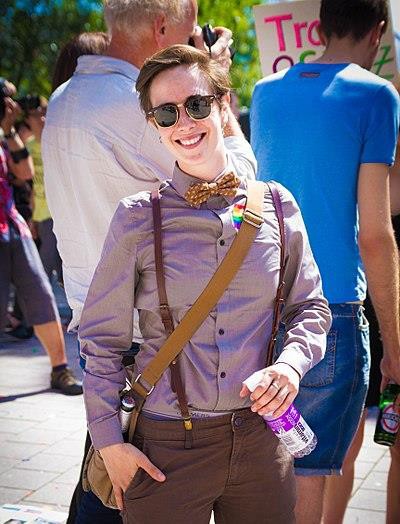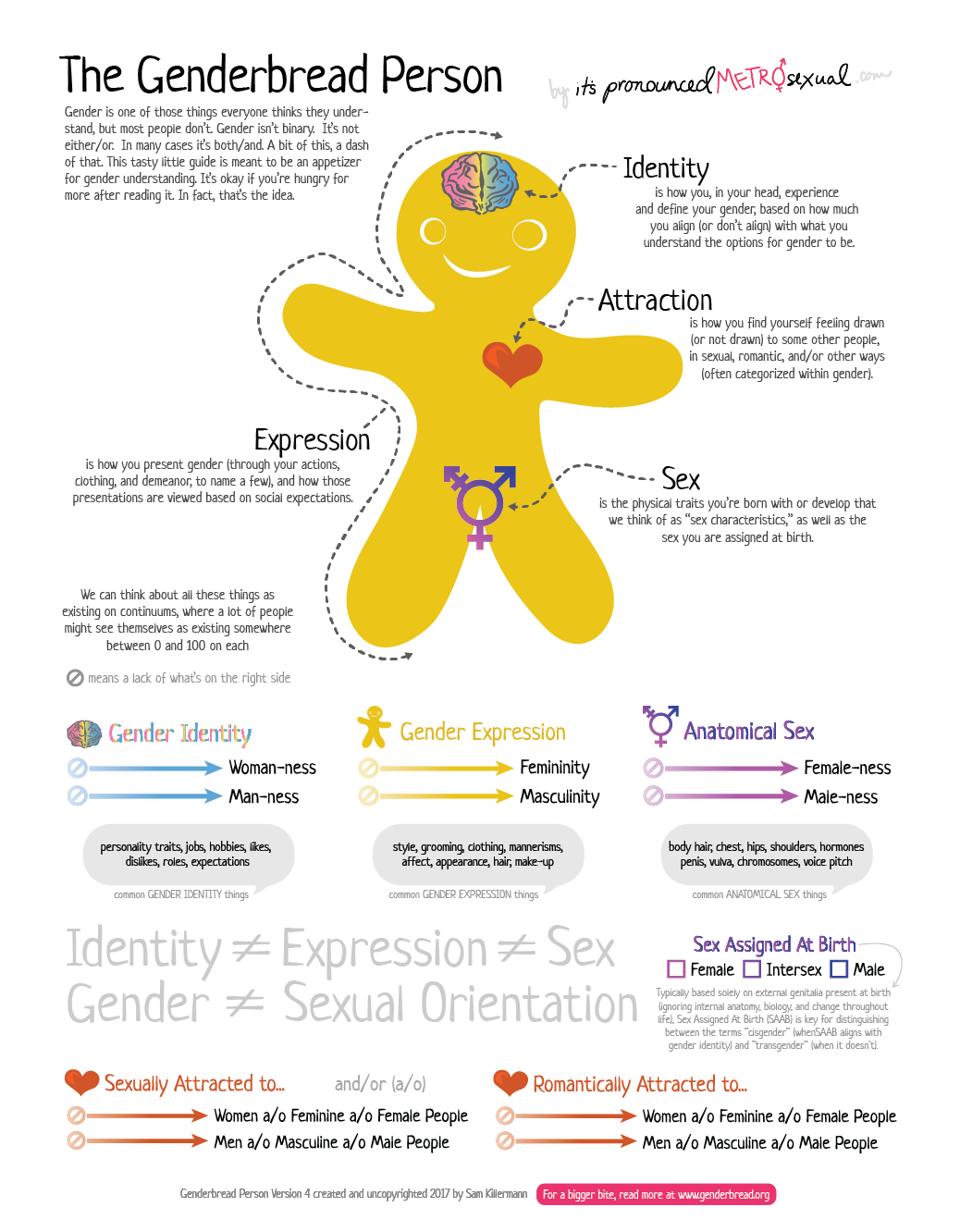131 Development of Gender Identity
“Sex,” refers to physical or physiological differences between males, females, and intersex persons, including both their primary and secondary sex characteristics. “Gender,” on the other hand, refers to social or cultural distinctions associated with a given gender.
When babies are born, they are assigned a gender based on their biological sex—male babies are assigned as boys, female babies are assigned as girls, and intersex babies are born with sex characteristics that do not fit the typical definitions for male or female bodies, and are usually relegated into one gender category or another. Scholars generally regard gender as a social construct, meaning that it doesn’t exist naturally but is instead a concept that is created by cultural and societal norms. From birth, children are socialized to conform to certain gender roles based on their biological sex and the gender to which they are assigned.[1]
A person’s subjective experience of their own gender and how it develops, or gender identity, is a topic of much debate. It is the extent to which one identifies with a particular gender; it is a person’s individual sense and subjective experience of being a man, a woman, or other gender. It is often shaped early in life and consists primarily of the acceptance (or non-acceptance) of one’s membership into a gender category. In many societies, there is a basic division between gender attributes assigned to males and females. In all societies, however, some individuals do not identify with some (or all) of the aspects of gender that are assigned to their biological sex.
Those that identify with the gender that corresponds to the sex assigned to them at birth (for example, they are assigned female at birth and continue to identify as a girl, and later a woman) are called cisgender. In many Western cultures, individuals who identify with a gender that is different from their biological sex (for example, they are assigned female at birth but feel inwardly that they are a boy or a gender other than a girl) are called transgender. Some transgender individuals, if they have access to resources and medical care, choose to alter their bodies through medical interventions such as surgery and hormonal therapy so that their physical being is better aligned with their gender identity.

Recent terms such as “genderqueer,” “genderfluid,” “gender variant,” “androgynous,” “agender,” and “gender nonconforming” are used by individuals who do not identify within the gender binary as either a man or a woman. Instead they identify as existing somewhere along a spectrum or continuum of genders, or outside of the spectrum altogether, often in a way that is continuously evolving.
The Gender Continuum
Viewing gender as a continuum allows us to perceive the rich diversity of genders, from trans- and cisgender to gender queer and agender. Most Western societies operate on the idea that gender is a binary, that there are essentially only two genders (men and women) based on two sexes (male and female), and that everyone must fit one or the other. This social dichotomy enforces conformance to the ideals of masculinity and femininity in all aspects of gender and sex—gender identity, gender expression, and biological sex.
According to supporters of queer theory, gender identity is not a rigid or static identity but can continue to evolve and change over time. Queer theory developed in response to the perceived limitations of the way in which identities are thought to become consolidated or stabilized (for instance, gay or straight), and theorists constructed queerness in an attempt to resist this. In this way, the theory attempts to maintain a critique rather than define a specific identity. While “queer” defies a simple definition, the term is often used to convey an identity that is not rigidly developed but is instead fluid and changing.[2]
Video briefly defines different gender identities.
The Genderbread Person
In 2012, Sam Killerman created the Genderbread Person as an infographic to break down gender identity, gender expression, biological sex, and sexual orientation.[3] He has since updated it to version 4.0 to be more accurate, and inclusive.[4]

Video talks through aspects of one’s identity that are highlighted with the Gingerbread Person model.
Gender Pronouns
Pronouns are a part of language used to refer to someone or something without using proper nouns. In standard English, some singular third-person pronouns are “he” and “she,” which are usually seen as gender-specific pronouns, referring to a man and a woman, respectively. A gender-neutral pronoun or gender-inclusive pronoun is one that gives no implications about gender, and could be used for someone of any gender.
Some languages only have gender-neutral pronouns, whereas other languages have difficulty establishing any that aren’t gender-specific. People with non-binary gender identities often choose new third-person pronouns for themselves as part of their transition. They often choose gender-neutral pronouns so that others won’t see them as female or male.[5]
Here is a table based on the Rainbow Coalition of Yellowknife’s Handy Guide to Pronouns offering three examples of pronouns people may use:
|
Pronouns |
Example |
|
He/His/Him (masculine pronouns) |
He is going to the store to buy himself a hat. I saw him lose his old hat yesterday. |
|
She/Her/Her (feminine pronouns) |
She is going to the store to buy herself a hat. I saw her lose her old hat yesterday. |
|
They/Them/Their (gender neutral pronouns) |
They are going to the store to buy themselves a hat. I saw them lose their old hat yesterday. |
Factors that Influence Gender Identity
Although the formation of gender identity is not completely understood, many factors have been suggested as influencing its development. Biological factors that may influence gender identity include pre- and post-natal hormone levels and genetic makeup. Social factors include ideas regarding gender roles conveyed by family, authority figures, mass media, and other influential people in a child’s life. According to social-learning theory, children develop their gender identity through observing and imitating the gender-linked behaviors of others; they are then “rewarded” for imitating the behaviors of people of the same gender and “punished” for imitating the behaviors of another gender. For example, male children will often be rewarded for imitating their father’s love of baseball but punished or redirected in some way if they imitate their older sister’s love of dolls. Children are shaped and molded by the people surrounding them, who they try to imitate and follow.
Gender Roles
The term “gender role” refers to society’s concept of how people of a particular gender are expected to act. As we grow, we learn how to behave from those around us. In this socialization process, children are introduced to certain roles that are typically linked to their biological sex. Gender roles are based on norms, or standards, created by society. In American culture, masculine roles have traditionally been associated with strength, aggression, and dominance, while feminine roles have traditionally been associated with passivity, nurturing, and subordination.
Gender Socialization
The socialization process in which children learn these gender roles begins at birth. Today, our society is quick to outfit male infants in blue and girls in pink, even applying these color-coded gender labels while a baby is in the womb. It is interesting to note that these color associations with gender have not always been what they are today. Up until the beginning of the 20th century, pink was actually more associated with boys, while blue was more associated with girls—illustrating how socially constructed these associations really are.
Gender socialization occurs through four major agents: family, education, peer groups, and mass media. Each agent reinforces gender roles by creating and maintaining normative expectations for gender-specific behavior. Exposure also occurs through secondary agents, such as religion and the workplace. Repeated exposure to these agents over time leads people to develop a sense that they are acting naturally based on their gender rather than following a socially constructed role.
Gender Stereotypes, Sexism, and Gender-Role Enforcement
The attitudes and expectations surrounding gender roles are not typically based on any inherent or natural gender differences, but on gender stereotypes, or oversimplified notions about the attitudes, traits, and behavior patterns of males and females. We engage in gender stereotyping when we do things like making the assumption that a teenage babysitter is female.
While it is somewhat acceptable for women to take on a narrow range of masculine characteristics without repercussions (such as dressing in traditionally male clothing), men are rarely able to take on more feminine characteristics (such as wearing skirts) without the risk of harassment or violence. This threat of punishment for stepping outside of gender norms is especially true for those who do not identify as male or female.

Gender stereotypes form the basis of sexism, or the prejudiced beliefs that value males over females. Common forms of sexism in modern society include gender-role expectations, such as expecting women to be the caretakers of the household. Sexism also includes people’s expectations of how members of a gender group should behave. For example, girls and women are expected to be friendly, passive, and nurturing; when she behaves in an unfriendly or assertive manner, she may be disliked or perceived as aggressive because she has violated a gender role (Rudman, 1998). In contrast, a boy or man behaving in a similarly unfriendly or assertive way might be perceived as strong or even gain respect in some circumstances.[7]
- Intersex by Wikipedia is licensed under CC BY-SA 3.0 ↵
- Boundless Psychology - Gender and Sexuality references Curation and Revision by Boundless Psychology, which is licensed under CC BY-SA 4.0 ↵
- The Genderbread Person by Sam Killermann is in the public domain ↵
- The Genderbread Person v4.0 by Sam Killermann is in the public domain ↵
- Pronouns by Nonbinary Wiki is licensed under CC BY-SA 4.0 ↵
- Rainbow Coalition of Yellowknife. (n.d). Handy Guide to Pronouns [PDF files]. Retrieved from http://www.rainbowcoalitionyk.org/resources/.; ↵
- Lifespan Development: A Psychological Perspective by Martha Lally and Suzanne Valentine-French is licensed under CC BY-NC-SA 3.0 (sections modified by Courtney Boise) ↵

